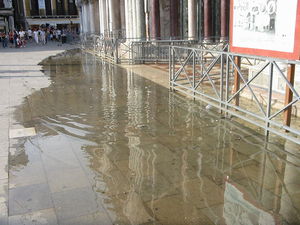Flooding
Causes Of Floods, Hydrologic Cycle, Human Populations, Human Influence On Flooding, Weight Of Water And Force Of Floods

Flooding, although it usually carries a negative connotation, is quite a natural process and is simply the response of a natural system (a river system) to the presence of too much water during an interval of time. Rivers and streams are governed by a simple equation, Q = A × V, where Q is discharge (amount of water), A is area of the river channel, and V is velocity. When excess discharge is present in a river or stream, at first the water moves more quickly (V increases) and perhaps some erosion of the channel takes place (i.e., A increases). If discharge (Q) increases too rapidly, however, water must move out of the channel (the confining area, [A]) and out onto the surrounding area, known as the floodplain. The floodplain is the area that floods first.
Floods are caused by a variety of factors, both natural and man-made. Some obvious causes of floods are heavy rains, melting snow and ice, and frequent storms within a short time duration. The common practice of humans to build homes and towns near rivers and other bodies of water (i.e., within natural floodplains) has contributed to the disastrous consequences of floods. In fact, floods have historically killed more people than any other form of natural disaster. Because of this fact, humans have attempted to manage floods using a variety of methods with varying degrees of success.
Additional topics
- Flooding - Causes Of Floods
- Flooding - Hydrologic Cycle
- Flooding - Human Populations
- Flooding - Human Influence On Flooding
- Flooding - Weight Of Water And Force Of Floods
- Flooding - Flood Intervention
- Other Free Encyclopedias
Science EncyclopediaScience & Philosophy: Ferroelectric materials to Form and matter